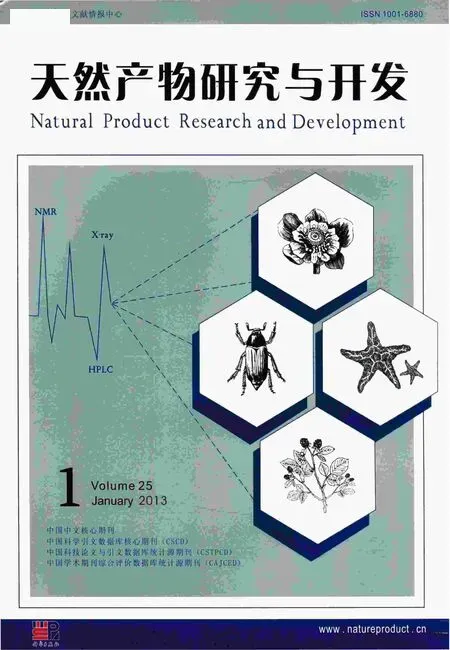玫瑰花的化学成分研究
2013-02-10刘红燕
刘红燕
山东中医药大学,济南250355
Introduction
Rose flower is one of the most popular herbal drugs used in the traditional Chinese medicine[1].It possesses antibacterial,antioxidant,anti-inflammatory activities and has been commonly used as a remedy for female genital diseases and blood stagnation[2]. Literatures have demonstrated that the bioactive constituents of rose flowers are polyphenolics,anthocyanins,flavonoids,tannins,triterpenoid glycosides,etc[2-6].In this study,additional four flavonoids and one organic acid were isolated from this medicinal plant for the first time,accompanied by two previously reported constituents[3].
Materials and Methods
Apparatus and reagents
Melting points were determined on an X-4 micro-melting point apparatus (YLN,Beijing)and uncorrected.NMR spectra were recorded on Bruker AM-500 with TMS as reference.Silica gel (200-300 mesh)used for column chromatography (CC)was supplied by Qingdao Marine Chemical Factory (Qingdao,China).Sephadex LH-20 was purchased from Pharmacia Biotech company (Pharmacia,Sweden).Reagents used were all analytical purity.
Plant material
The flowers of R.rugosa L.were collected from Pingyin(Shandong province,China)and authenticated by Prof PENG Yan-li.A voucher specimen was deposited in the herbarium of Shandong university of TCM (SDCM).
Preparation of extracts
The finely powdered flowers of R. rugosa L. (5 kg)were extracted three times with 80% ethanol at room temperature.The filtered solvent was evaporated off by rotary evaporator to yield 1.2 kg of crude extract,which was suspended in H2O and partitioned with petroleum ether,CHCl3,EtOAc and n-BuOH,sequentially. The EtOAc extract (160 g)was subjected to silica gel CC(200-300 mesh) and eluted with CHCl3- MeOH(100:0-0:100)to afford Frs. 1-5. From Fr. 1,compound 2(22 mg)was obtained by silica gel CC and recrystallization. From Fr. 2,compound 1(15 mg)was obtained by silica gel CC and preparative TLC. Fr. 3 was further purified by Sephadex LH-20 with CHCl3-MeOH to yield compounds 3 (35 mg)and 5 (20 mg).From Fr. 4,compounds 4 (13 mg)and 7 (23 mg)were obtained by repeated silica gel CC and Sephadex LH-20.Compound 6 (14 mg)was yielded from Fr.5.
Structural identification results
Gallic acid (1) was obtained as white needle crystal(MeOH)with a melting point of 234-235 ℃. This compound showed positive reaction result in FeCl3test.1H NMR (DMSO-d6,500 Hz)δ:6.90 (2H,s,H-2,6),8.79 (1H,s,OH-4),8.84 (2H,s,OH-3,5),12.22 (1H,br,COOH),9.17 (2H,s),8.80 (1H,s);13C NMR (DMSO-d6,125 Hz)δ:167.38 (>C =O),108.7(C-2,C-6),120.433 (C-1),137.93 (C-4),145.4 (C-3,C-5).
Caffeic acid (2) was obtained as yellow powder(MeOH)with a melting point of 190-191 ℃.1H NMR(DMSO-d6,500 Hz)δ:12.11 (1H,brs,-COOH),9.52 (1H,brs,4-OH),9.12 (1H,brs,3-OH),7.42(1H,d,J = 16.2 Hz,H-7),7.01 (1H,s,H-2),6.96(1H,dd,J = 1.8,7.8 Hz,H-6),6.75 (1H,d,J =7.8 Hz,H-5),6.17 (1H,d,J = 16.2 Hz,H-8);13C NMR (DMSO-d6,125 Hz)δ:168.4 (C-9),146.1(C-4),148.7 (C-3),145.0 (C-7),126.2 (C-1),115.7 (C-8),115.2 (C-2),l16.3 (C-5),l21.7 (C-6).
Luteolin (3) was obtained as yellow needle crystal(MeOH)with a melting point of 346-347 ℃. It responded positively in HCI-Mg reaction,negatively in Molish test and showed golden fluorescence under UV lamp.1H NMR (DMSO-d6,500 Hz)δ:12.97 (1H,s,5-OH),10.8 (1H,s,7-OH),9.93 (1H,s,4'-OH),9.39 (1H,s,3'-OH),7.41 (1H,dd,J = 8.4,1.8 Hz,H-6'),7.39 (1H,d,J = 1.8 Hz,H-2'),6.89(1H,d,J = 8.4 Hz,H-5'),6.66 (1H,s,H-3),6.43(1H,d,J = 1.8 Hz,H-8),6.18 (1H,d,J = 1.8 Hz,H-6);13C NMR (DMSO-d6,125 Hz)δ:163.8(C-2),102.8 (C-3),181.6 (>C = O),161.4 (C-5),98.8 (C-6),164.0 (C-7),93.8 (C-8),157.2(C-9),103.6 (C-l0),121.5 (C-1'),113.3 (C-2'),145.7 (C-3'),149.7 (C-4'),115.9 (C-5'),118.9(C-6').
Quercetin (4) was obtained as yellow-green powder(MeOH)with a melting point of 313-314 ℃. It responded positively in HCI-Mg reaction and negtively in Molish test.1H NMR (DMSO-d6,500 Hz)δ:12.50(1H,s,C5-OH),9.35 (1H,s,C7-OH),7.67 (1H,s,C3-OH),7.93 (1H,s,C3'-OH),7.86 (1H,s,C4'-OH),7.68 (1H,d,J = 2.4 Hz,H-2'),7.55 (1H,dd,J = 2.4,8.4 Hz,H-6'),6.89 (1H,d,J = 8.4 Hz,H-5'),6.41(1H,d,J = 1.8 Hz,H-8),6.19(1H,d,J = 1.8 Hz,H-6);13C NMR (DMSO-d6,125 Hz)δ:146.7 (C-2),135.7 (C-3),175.8 (>C =O),160.7 (C-5),98.2 (C-6,-CH-),163.8 (C-7),93.3 (C-8,-CH-),156.1 (C-9),103.0 (C-10),121.9 (C-1'),115.0 (C-2',-CH-),145.0 (C-3'),147.6 (C-4'),115.6 (C-5',-CH-),119.9 (C-6',-CH-).
Pinocembrin-7-O-β-D-glucopyranoside (5) was obtained as white needle crystal (MeOH)with a melting point of 130-132 ℃. It responded positively in HCI-Mg reaction.1H NMR (DMSO-d6,500 Hz)δ:5.65 (1H,dd,J = 12.3,3.0 Hz,H-2),3.23 (1H,dd,J = 12.3,17.1 Hz,H-3a),2.85 (1H,dd,J =17.1,3.0 Hz,H-3b),6.19 (1H,d,J = 1.81 Hz,H-6),6.14 (1H,d,J = 1.81 Hz,H-8),7.53 (2H,d,J= 7.2 Hz,H-2',6'),7.45 (H-3',4',5'),4.0-4.6(H-Glu);13C NMR (DMSO-d6,125 Hz)δ:78.5 (C-2),42.1 (C-3),196.6 (>C = O),162.9 (C-5),96.6 (C-6),165.3 (C-7),95.4 (C-8),162.4 (C-9),103.2 (C-10),138.4 (C-1'),126.6 (C-2'),128.5 (C-3'),128.5 (C-4'),128.5 (C-5'),126.6(C-6'),99.5 (Glc-1),72.9 (Glc-2),76.2 (Glc-3),69.4 (Glc-4),77.0 (Glc-5),60.5 (Glc-6).
Quercetin-4'-O-β-D-glucoside (6) was obtained as yellow powder (MeOH)with a melting point of 193-194 ℃. It responded positively in HCI-Mg reaction and Molish test.1H NMR (DMSO-d6,500 Hz)δ:12.41(1H,s,5-OH),10.82 (1H,s,7-OH),7.69 (1H,d,J= 1.8 Hz,H-2'),7.60 (1H,dd,J = 1.8,8.4 Hz,H-6'),7.23 (1H,d,J = 8.4 Hz,H-5'),6.44 (1H,d,J = 1.8 Hz,H-8),6.18 (1H,d,J = 1.8 Hz,H-6),5.41 (1H,d,J = 7.5 Hz,H-1'');13C NMR(DMSO-d6,125 Hz)δ:146.3 (C-2),136.3 (C-3),175.9 (>C=O),160.7 (C-5),98.1 (C-6),163.9(C-7),93.4 (C-8),156.1 (C-9),103.0 (C-10),125.1 (C-1'),115.1 (C-2'),146.7 (C-3'),145.8(C-4'),115.8 (C-5'),119.4 (C-6'),101.4 (C-1''),73.7 (C-2''),75.9 (C-3''),69.7 (C-4''),77.2 (C-5''),60.6 (C-6'').
Acacetin-7-O-rutinoside (7) was obtained as pale yellow needle crystal (MeOH)with a melting point of 260-262 ℃. It responded positively in HCI-Mg reaction and Molish test.1H NMR (DMSO-d6,500 Hz)δ:12.90 (1H,s,5-OH),6.95 (1H,s,H-3),8.06 (2H,d,J = 8.4 Hz,H-2',6'),7.15 (2H,d,J = 8.4 Hz,H-3',5'),6.78 (1H,J = 2.4 Hz,H-8),6.45 (1H,d,J = 1.8 Hz,H-6),3.85 (3H,s,-OCH3),5.44(1H,d,J = 7.2 Hz,H-1'''),5.06 (1H,d,J = 7.2 Hz,H-1''),1.08 (3H,d,J = 6 Hz,6'''-CH3);13C NMR (DMSO-d6,125 Hz)δ:163.8 (C-2),103.7(C-3),181.9 (>C = O),162.3 (C-5),99.6 (C-6),162.9 (C-7),94.7 (C-8),156.9 (C-9),105.4(C-10),122.6 (C-1'),128.4 (C-2',6'),114.5 (C-3',5'),161.1 (C-4'),100.4 (C-1''),73.0 (C-2''),75.6 (C-3''),70.3 (C-4''),76.2 (C-5''),66.0 (C-6''),99.9 (C-1'''),70.7 (C-2'''),69.6(C-3'''),72.0 (C-4'''),68.2 (C-5'''),17.7 (C-6'''),55.5 (-OCH3).
1 Chinese Pharmacopoeia Commission. Pharmacopoeia of the People's Republic of China. Beijing:China Medical Science Press,2005.Vol I:139.
2 Hirulkar NB,Agrawal M.Antimicrobial activity of rose petals extract against some pathogenic bacteria.J Pham Biomed Anal,2010,1:478-484.
3 Xiao ZP,Wu HK,Wu T,et al.Kaempferol and quercetin flavonoids from Rosa rugosa. Chem Nat Compd,2006,42:736-737.
4 Zheng JB,Liu XX,Zhou YZ. Simultaneous determination of five phenolic compounds in dried flowers by LC using DAD combined electrochemical detection.Chromatographia,2007,12:707-712.
5 Dobson HEM,Bergström G,Groth I. Tannins of rosaceous plants. VIII. Hydrolyzable tannin monomers having a valoneoyl group from flower petals of Rosa rugosa Thunb.Israel J Botany,1990,39:143-156.
6 Hun SY,Jong CP,Jae SC.Triterpenoid glycosides from Rosa rugosa.Arch Pharm Res,1987,10:219-222.
